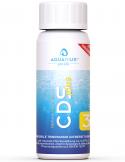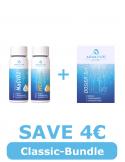Clean drinking water in nature – The best method for water treatment
Imagine you are on a multi-day hike, your water supply is slowly running out, and the only stream nearby looks clear. Can you really drink the water without hesitation, you ask yourself?
Care is needed. In nature, invisible dangers lurk in the water: bacteria, parasites, and chemical contaminants can be found even in crystal-clear mountain springs. Without the right treatment, a single sip can cause serious health problems.
But don't worry – with the right method, you can safely treat your water in any environment. In this article, you will learn:
✔️ Why water in nature is often contaminated
✔️ What methods of water treatment are available
✔️ Why chlorine dioxide is the best solution for outdoor adventurers
Is clear water the same as clean water?
Many believe that water from a flowing stream or spring is always drinkable. However, even clear water can be full of unseen dangers:
? Bacteria & parasites: Giardia (a parasite) & E. coli can cause gastrointestinal illnesses.
☠ Viruses: In certain regions, hepatitis A viruses or noroviruses are also a risk.
? Heavy metals & chemicals: Pesticides, fertilisers or heavy metals from the soil can contaminate even the most remote water sources.
A water source may seem harmless, but without the right treatment, you risk your health.
Water treatment – what methods are there?
When you're out and about, there are a number of ways to make water drinkable. But not every method is equally effective:
1️⃣ Boiling – the classic method with pitfalls
? Boil water for at least five minutes – sounds simple, doesn't it? But there are some disadvantages:
⚠ Time-consuming and laborious – you need fuel, time and a suitable container.
⚠ No protection against chemicals or heavy metals – Heating kills germs, but it doesn't remove chemical residues.
? Conclusion: Good as a stopgap, but not always practical.
2️⃣ Portable water filter – Helpful, but not perfect
? Portable water filters are popular with outdoor enthusiasts because they quickly and easily remove bacteria and dirt. But be careful:
⚠ Not all filters block viruses! Many standard filters only retain bacteria.
⚠ Regular cleaning necessary – A clogged filter quickly becomes unusable.
⚠ Wears out – The filter cartridges need to be replaced regularly.
? Conclusion: Useful, but not sufficient as a standalone solution.
3️⃣ Chlorine dioxide – The best solution for outdoor adventurers
? Chlordioxid is one of the most effective methods of water treatment and is used worldwide by outdoor professionals, expedition teams and even the military.
? Advantages of chlorine dioxide:
✔️ Kills 99.9% of all bacteria, viruses & parasites – reliably against Giardia & E. coli.
✔️ Neutralises biofilms – removes algae and deposits in drinking water containers.
✔️ Extremely light and compact – ideal for trekking, survival and emergency preparedness.
✔️ No aftertaste, no harmful by-products – unlike chlorine, it maintains the natural taste.
✔️ Effective against chemicals – can break down pesticides and other organic substances.
? Use:
A few drops are enough to safely disinfect several litres of water – just mix, wait a moment and drink with confidence!
? Conclusion: the ideal solution for adventurers who want to play it safe.
When should you ALWAYS treat your water?
Whether you find a spring while hiking or draw from a lake while camping, these situations always require water treatment:
? When camping & trekking – even ‘clean’ streams can be contaminated.
? On bikepacking or canoeing tours – standing water often has a high bacterial load.
✈ When travelling in foreign countries – even tap water can be problematic.
? In emergencies & crisis situations – contaminated water can quickly become a danger.
Bottom line: are you ready for your next adventure?
When you're out and about, clean drinking water is essential for survival. While boiling and filtering have their limitations, chlorine dioxide offers a simple, safe and effective solution for every situation.
Share this content



